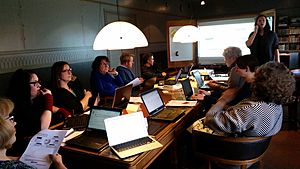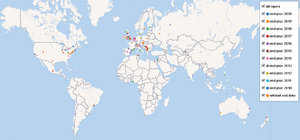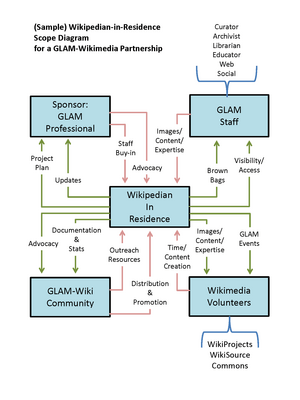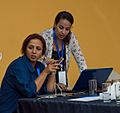Wikimedian in Residence facts for kids

A Wikimedian in Residence is a special person who works with an organization. They are sometimes called a Wikipedian in Residence. People often shorten this name to WiR.
WiRs help people at an organization understand how Wikipedia works. They also teach about Wikipedia's other projects, like Wikimedia Commons (for images and videos), Wikidata (for facts and data), and Wikisource (for books and documents). WiRs usually don't write about the organization they work for. Instead, they help experts at that place share their knowledge on Wikipedia and its sister sites.
WiRs work with many different kinds of groups. Most often, they work with GLAMs. GLAM stands for Galleries (like art museums), Libraries, Archives, and Museums. Some WiRs work in schools or universities. Sometimes, a WiR might work with several organizations at once. When this happens, they can be called a "Wikimedian at Large". For example, one WiR worked with many groups across New Zealand. Some WiRs are paid by the organization they work for, or by a group connected to Wikimedia. Others are volunteers who do it for free.
Contents
The History of WiRs
The very first Wikimedian in Residence started working at the British Museum in 2010. This was a big step for Wikipedia and cultural groups.
By 2016, more than 100 people had been a WiR. By 2020, this number grew to over 220 people around the world.
How WiRs Help Organizations
WiRs help organizations in many ways. They teach staff how to edit Wikipedia. They also show how to add information to other Wikimedia projects. This helps the organization share its collections and knowledge with the world.
For example, a WiR might help a museum upload pictures of its art to Wikimedia Commons. This means people everywhere can see the art online. They might also help a library add details about its old books to Wikidata. This makes it easier for researchers to find information.
WiRs also help make sure that the information added is neutral and correct. They follow Wikipedia's rules for reliable sources. This helps keep Wikipedia a trusted place for learning.
Why WiRs are Important
WiRs are important because they connect organizations with the Wikimedia world. They help share knowledge that might otherwise stay hidden. By working together, more people can learn about history, art, science, and many other topics.
They also help organizations understand the power of open knowledge. Open knowledge means information is free for everyone to use and share. This helps make learning available to more people around the globe.
Images for kids
-
UNESCO Memory of the World WiR talking at the Zeeuws Archief.
-
WiRs who are librarians in Tunis
See also
 In Spanish: Wikipedista residente para niños
In Spanish: Wikipedista residente para niños






